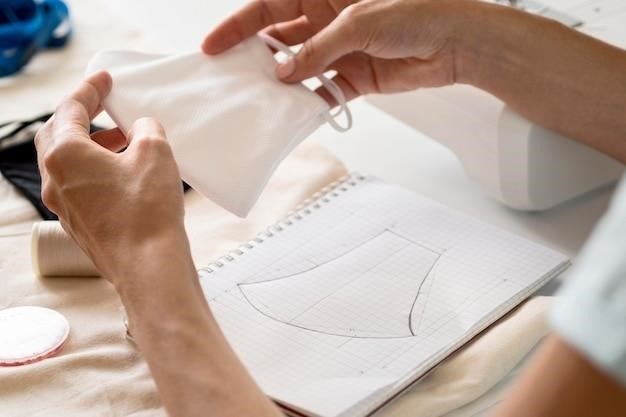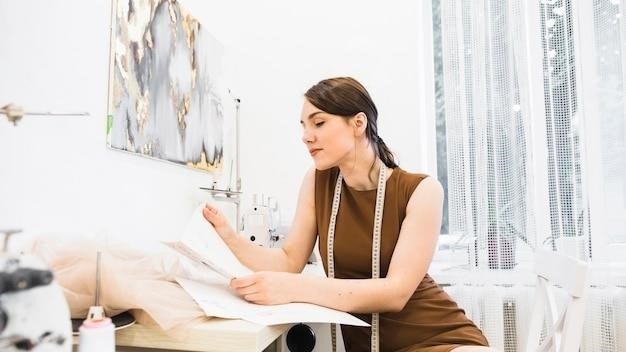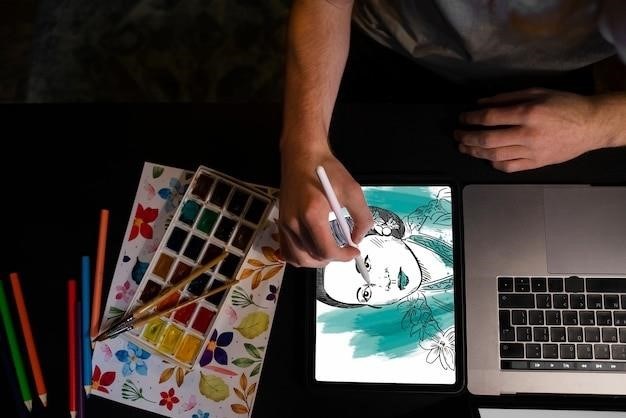Butterick 4790⁚ A Comprehensive Guide
This guide delves into the world of Butterick 4790, a renowned vintage sewing pattern known for its iconic “Walkaway Dress.” We’ll explore its history, pattern details, sewing techniques, fabric recommendations, and tips for achieving a perfect fit. Join us as we unravel the secrets behind this timeless garment and empower you to create your own stunning Walkaway Dress.
Introduction
The Butterick 4790 pattern, affectionately nicknamed the “Walkaway Dress,” has captured the hearts of vintage sewing enthusiasts for decades. This simple yet elegant wrap dress, inspired by the original 1950s design, epitomizes the classic femininity and effortless style of the era. Its popularity stems from its ease of construction, featuring a mere three pattern pieces and minimal fuss. The design’s versatility allows for countless variations, from timeless and elegant to playful and modern. Whether you’re a seasoned sewist or a beginner eager to try a vintage project, Butterick 4790 presents a rewarding and achievable sewing journey.
This comprehensive guide will lead you through every step of creating your own Walkaway Dress, from selecting the perfect fabric to adding finishing touches. We’ll explore the history of the pattern, its unique design elements, and offer detailed instructions for sewing a flawless garment. Whether you’re aiming for an authentic 1950s look or putting your own creative spin on the design, this guide will equip you with the knowledge and confidence to make your own stunning Walkaway Dress.
The History of Butterick 4790
The Butterick 4790 pattern has a rich history, tracing its roots back to the iconic “Walkaway Dress” of the 1950s. The original pattern, Butterick 6015, was released in 1952 and quickly gained popularity for its simplicity and flattering silhouette. The design was so well-received that it became a symbol of the era, gracing countless fashion magazines and inspiring countless home sewers. The “Walkaway Dress” was named for its ease of construction; the design was so straightforward that it could be sewn quickly, allowing the wearer to “walk away” in their newly made dress. This characteristic remains true for the re-released version, Butterick 4790.
In recent years, Butterick reintroduced the pattern as part of their Retro line, bringing the iconic “Walkaway Dress” back to a new generation of sewists. The re-release, Butterick 4790, has become a favorite among vintage sewing enthusiasts, offering a chance to experience the nostalgia and timeless elegance of the 1950s. While the original pattern has become a collector’s item, the re-released version allows sewists to recreate this beloved style with modern materials and techniques.
The Walkaway Dress⁚ A 1950s Icon
The Walkaway Dress, as it’s affectionately known, embodies the quintessential style of the 1950s. This iconic garment, epitomized by Butterick 4790, captured the essence of a decade defined by elegance and femininity. The dress’s signature features include its wrap-around design, flattering sheath silhouette, and emphasis on a nipped-in waist. These elements combined to create a look that was both timeless and effortlessly chic. The Walkaway Dress was a versatile piece that could be dressed up for a special occasion or worn casually for everyday wear. It was a staple in the wardrobes of women across the globe, showcasing the power of simple elegance and the enduring appeal of classic design.
The dress’s popularity was further fueled by its ease of construction. The “Walkaway” moniker alluded to the pattern’s simplicity, allowing even novice sewists to create a stunning garment with minimal effort. This accessibility made it a favorite among home sewers, further solidifying its place in fashion history. The Walkaway Dress became a symbol of empowerment, allowing women to express their creativity and style through the art of sewing. It was a dress that celebrated individuality, allowing women to personalize their wardrobe with unique fabric choices and embellishments.
Butterick 4790⁚ Pattern Details
Butterick 4790, the re-released version of the original 1952 pattern, presents a straightforward yet elegant design. The pattern consists of a mere three pieces⁚ a front panel, a back panel, and a skirt. The front panel features bust darts, while both the front and back panels include waist darts. The back panel is designed to wrap around to the front, creating the signature sheath-and-overskirt look. This wrap-around style is a key feature of the Walkaway Dress, adding a touch of effortless sophistication. The pattern offers two variations⁚ one with a contrast back and skirt, and another with bias tape finished edges.
The pattern is sized for misses, ranging from sizes 8-14 and 16-22. It’s important to note that the pattern is designed for a 1950s silhouette, which typically emphasizes a nipped-in waist and a full skirt. This means you may need to adjust the pattern to fit your individual measurements and desired style. The pattern includes instructions for creating a casing at the top of the dress, which allows for the insertion of elastic to achieve the desired fit. The bottom edge of the dress is left unfinished, suggesting a simple zigzag or serged finish.
Sewing the Walkaway Dress⁚ A Step-by-Step Tutorial
Sewing the Walkaway Dress is a rewarding experience that allows you to bring a piece of vintage fashion to life. The process, while not overly complex, requires attention to detail and careful execution. Here’s a step-by-step guide to help you along the way⁚
Fabric and Supplies⁚ Choose a fabric that complements the 1950s aesthetic, such as cotton, linen, or silk. You’ll also need basic sewing supplies, including thread, needles, scissors, pins, and a sewing machine.
Cutting and Marking⁚ Carefully cut out the pattern pieces according to your size and desired length. Mark all darts, seams, and other important markings using a fabric pencil or tailor’s chalk.
Sewing the Darts and Seams⁚ Begin by sewing the darts on the front and back panels. This helps to shape the dress and create a flattering fit. Then, sew the shoulder seams, followed by the back waist seam.
Finishing Touches⁚ Once the main seams are sewn, you can finish the edges of the dress using a serger or a zigzag stitch. Create a casing at the top of the dress to accommodate elastic. Insert the elastic and sew the casing closed.
Optional Details⁚ For an authentic 1950s look, you can add a grosgrain sash or a wide vinyl belt at the waist. You can also experiment with different sleeve styles or neckline variations.
Final Touches⁚ Press all seams and hem the bottom edge of the dress. Enjoy your newly crafted Walkaway Dress!
Fabric and Supplies
Choosing the right fabric and gathering the necessary supplies is crucial for a successful Walkaway Dress project. The fabric you select will greatly influence the overall look and feel of your dress, so careful consideration is essential.
Here’s a guide to fabric choices and essential supplies⁚
Fabric⁚
- Cotton⁚ A classic and versatile choice, cotton is easy to sew and care for. It drapes beautifully and is available in a wide array of colors and prints.
- Linen⁚ Linen is a lightweight and breathable fabric that is perfect for warm weather. It has a natural texture and a slightly slubby appearance.
- Silk⁚ For a more luxurious look, silk is a beautiful and flowing fabric. It can be a bit more challenging to sew, but the results are worth it.
- Rayon⁚ Rayon is a synthetic fabric that drapes well and is often used for vintage-inspired dresses. It comes in a variety of colors and textures.
Supplies⁚
- Sewing Machine⁚ A reliable sewing machine is essential for this project.
- Thread⁚ Choose a matching thread color for your fabric.
- Needles⁚ Universal needles are suitable for most fabrics.
- Scissors⁚ A good pair of fabric scissors is important for clean cuts.
- Pins⁚ Use pins to hold fabric pieces together while sewing.
- Fabric Pencil or Tailor’s Chalk⁚ For marking darts, seams, and other markings.
- Measuring Tape⁚ For accurate measurements.
- Iron⁚ For pressing seams and finishing the dress.
- Elastic⁚ For the waistband casing.
- Optional⁚ Grosgrain sash, wide vinyl belt, bias tape, and embellishments.
Cutting and Marking
Before you start sewing, you need to cut out your fabric pieces and mark the darts and seams. Here’s a step-by-step guide⁚
Prepare Your Fabric⁚
- Pre-wash and iron your fabric to prevent shrinkage and ensure smooth sewing.
- Fold the fabric in half, aligning the selvages (the edges of the fabric) to ensure symmetrical cutting.
Lay Out the Pattern Pieces⁚
- Refer to the Butterick 4790 pattern instructions to determine the correct size and layout of the pattern pieces on your fabric;
- Pin the pattern pieces to the fabric, ensuring they are aligned with the fold and grain line.
Cut the Fabric⁚
- Carefully cut out the fabric pieces following the pattern markings. Use sharp fabric scissors for clean cuts.
Mark the Darts and Seams⁚
- Using a fabric pencil or tailor’s chalk, mark the darts and seams on the fabric pieces. These markings will guide you during sewing.
- Follow the pattern instructions for specific markings and ensure they are accurate.
- If you’re using a dark fabric, use white chalk. For light fabrics, use a pencil or a fabric pen designed for dark fabrics.
Double-Check Your Work⁚
- Before you start sewing, review your markings and ensure they are accurate. Double-check that all pattern pieces are cut correctly.
Sewing the Darts and Seams
Now it’s time to sew those darts and seams to bring your Walkaway Dress to life. Here’s a step-by-step guide⁚
Sewing the Darts⁚
- Start by sewing the darts. Darts are folds of fabric that shape the garment and create a more flattering fit.
- Using a sewing machine or by hand, stitch along the marked dart lines, leaving a small opening at the wide end of the dart for turning.
- Trim the seam allowance close to the stitching, but be careful not to cut into the stitching itself.
- Turn the darts right side out through the opening and press them flat. Close the opening with a few hand stitches.
Sewing the Seams⁚
- Sew the shoulder seams, back waist seams, and side seams according to the pattern instructions.
- Use a straight stitch and a seam allowance as indicated on the pattern.
- Press the seams open to prevent bulkiness.
- If your fabric is prone to fraying, consider finishing the seam edges with a serger or zigzag stitch.
Check for Fit⁚
- Before you move on to the next steps, try on the dress to check for fit.
- Adjust any seams if necessary to achieve the desired look and ensure a comfortable fit;
Remember to take your time, follow the pattern instructions carefully, and press your seams as you go. These steps will ensure a neat and professional-looking finished garment.
Finishing Touches
With the major construction complete, it’s time to add those finishing touches that elevate your Walkaway Dress from ordinary to extraordinary.
Hemming the Dress⁚
- Fold up the hem allowance of the dress skirt to the desired length, pressing it firmly.
- Sew the hem in place using a straight stitch or a blind hem stitch, depending on your preference and the type of fabric you’re using.
- Press the hem again after sewing to create a crisp, clean finish.
Adding Bias Tape⁚
- The pattern often calls for bias tape to finish the neck and armhole edges.
- Fold the bias tape in half lengthwise and press it flat.
- Pin the bias tape to the raw edges of the neck and armholes, ensuring it is evenly distributed.
- Sew the bias tape in place using a straight stitch, stitching close to the folded edge.
- Fold the bias tape to the inside of the garment and press it down. Sew the folded edge in place to create a neat, professional finish.
Optional Embellishments⁚
- Consider adding embellishments like a belt, buttons, or a bow to personalize your Walkaway Dress.
- A fabric belt or a grosgrain ribbon can accentuate the waistline and add a touch of elegance.
- Buttons can be used to create a unique closure for the back wrap.
- A large bow tied at the back adds a touch of whimsy and charm.
These finishing touches will give your Walkaway Dress a polished and professional look, showcasing your sewing skills and creating a garment that you’ll be proud to wear.
Tips and Tricks for a Perfect Fit

Achieving a perfect fit for your Walkaway Dress is crucial to its flattering silhouette and overall success. Here are some tips and tricks to help you achieve that coveted fit⁚
Understanding the Pattern’s Fit⁚
- Butterick 4790 is designed for a close-fitting, yet comfortable fit. It’s important to choose the correct size based on your bust, waist, and hip measurements.
- Don’t be afraid to adjust the pattern pieces for a perfect fit. This may involve adding or removing darts, adjusting the length of the skirt, or making changes to the shoulder seams.
Muslin Mock-Up⁚
- Before cutting your final fabric, create a muslin mock-up. This allows you to try on the dress and make any necessary adjustments before committing to the actual fabric.
- Muslin is an inexpensive and forgiving fabric, making it ideal for testing the fit and making adjustments.
Adjusting the Darts⁚
- The darts in the front and back of the dress are essential for shaping the bodice and creating a flattering fit.
- If the darts are too long or too short, adjust them accordingly. Use a ruler and tailor’s chalk to mark the new dart lines.
- Pin the adjusted darts and try on the dress to ensure they are in the correct location.
Getting Professional Help⁚

- If you’re struggling to achieve a perfect fit, consider seeking professional help from a seamstress or tailor.
- A professional can offer expert guidance and help you make the necessary adjustments to achieve a flawless fit.
By following these tips and tricks, you can ensure that your Walkaway Dress fits you perfectly, accentuating your figure and making you feel confident and beautiful.



